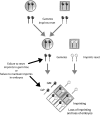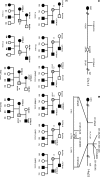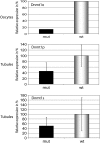Parental effect of DNA (Cytosine-5) methyltransferase 1 on grandparental-origin-dependent transmission ratio distortion in mouse crosses and human families
- PMID: 18202356
- PMCID: PMC2206083
- DOI: 10.1534/genetics.107.081562
Parental effect of DNA (Cytosine-5) methyltransferase 1 on grandparental-origin-dependent transmission ratio distortion in mouse crosses and human families
Abstract
Transmission ratio distortion (TRD) is a deviation from the expected Mendelian 1:1 ratio of alleles transmitted from parents to offspring and may arise by different mechanisms. Earlier we described a grandparental-origin-dependent sex-of-offspring-specific TRD of maternal chromosome 12 alleles closely linked to an imprinted region and hypothesized that it resulted from imprint resetting errors in the maternal germline. Here, we report that the genotype of the parents for loss-of-function mutations in the Dnmt1 gene influences the transmission of grandparental chromosome 12 alleles. More specifically, maternal Dnmt1 mutations restore Mendelian transmission ratios of chromosome 12 alleles. Transmission of maternal alleles depends upon the presence of the Dnmt1 mutation in the mother rather than upon the Dnmt1 genotype of the offspring. Paternal transmission mirrors the maternal one: live-born offspring of wild-type fathers display 1:1 transmission ratios, whereas offspring of heterozygous Dnmt1 mutant fathers tend to inherit grandpaternal alleles. Analysis of allelic transmission in the homologous region of human chromosome 14q32 detected preferential transmission of alleles from the paternal grandfather to grandsons. Thus, parental Dnmt1 is a modifier of transmission of alleles at an unlinked chromosomal region and perhaps has a role in the genesis of TRD.
Figures





Similar articles
-
Inheritance patterns of maternal alleles in imprinted regions of the mouse genome at different stages of development.Mamm Genome. 2002 Jan;13(1):24-9. doi: 10.1007/s00335-001-2095-x. Mamm Genome. 2002. PMID: 11773965
-
Dnmt1 overexpression causes genomic hypermethylation, loss of imprinting, and embryonic lethality.Mol Cell Biol. 2002 Apr;22(7):2124-35. doi: 10.1128/MCB.22.7.2124-2135.2002. Mol Cell Biol. 2002. PMID: 11884600 Free PMC article.
-
Domain-specific response of imprinted genes to reduced DNMT1.Mol Cell Biol. 2010 Aug;30(16):3916-28. doi: 10.1128/MCB.01278-09. Epub 2010 Jun 14. Mol Cell Biol. 2010. PMID: 20547750 Free PMC article.
-
Role of Mammalian DNA Methyltransferases in Development.Annu Rev Biochem. 2020 Jun 20;89:135-158. doi: 10.1146/annurev-biochem-103019-102815. Epub 2019 Dec 9. Annu Rev Biochem. 2020. PMID: 31815535 Review.
-
Imprinting of the mouse Igf2r gene depends on an intronic CpG island.Mol Cell Endocrinol. 1998 May 25;140(1-2):9-14. doi: 10.1016/s0303-7207(98)00022-7. Mol Cell Endocrinol. 1998. PMID: 9722161 Review.
Cited by
-
Whole-genome resequencing reveals loci with allelic transmission ratio distortion in F1 chicken population.Mol Genet Genomics. 2021 Mar;296(2):331-339. doi: 10.1007/s00438-020-01744-z. Epub 2021 Jan 6. Mol Genet Genomics. 2021. PMID: 33404883
-
Analysis of Case-Parent Trios Using a Loglinear Model with Adjustment for Transmission Ratio Distortion.Front Genet. 2016 Aug 31;7:155. doi: 10.3389/fgene.2016.00155. eCollection 2016. Front Genet. 2016. PMID: 27630667 Free PMC article.
-
Bypassing Mendel's First Law: Transmission Ratio Distortion in Mammals.Int J Mol Sci. 2023 Jan 13;24(2):1600. doi: 10.3390/ijms24021600. Int J Mol Sci. 2023. PMID: 36675116 Free PMC article. Review.
-
Over-expression of the miRNA cluster at chromosome 14q32 in the alcoholic brain correlates with suppression of predicted target mRNA required for oligodendrocyte proliferation.Gene. 2013 Sep 10;526(2):356-63. doi: 10.1016/j.gene.2013.05.052. Epub 2013 Jun 6. Gene. 2013. PMID: 23747354 Free PMC article.
-
Parent-of-origin effects of A1CF and AGO2 on testicular germ-cell tumors, testicular abnormalities, and fertilization bias.Proc Natl Acad Sci U S A. 2016 Sep 13;113(37):E5425-33. doi: 10.1073/pnas.1604773113. Epub 2016 Aug 31. Proc Natl Acad Sci U S A. 2016. PMID: 27582469 Free PMC article.
References
-
- Allen, N. D., M. L. Norris and M. A. Surani, 1990. Epigenetic control of transgene expression and imprinting by genotype-specific modifiers. Cell 61: 853–861. - PubMed
-
- Aranha, I. P., and P. A. Martin-DeLeon, 1991. The murine Rb(6.16) translocation: evidence for sperm selection and a modulating effect of aging. Hum. Genet. 87: 278–284. - PubMed
-
- Cattanach, B. M., and C. V. Beechey, 1990. Autosomal and X-chromosome imprinting. Dev. Suppl. pp. 63–72. - PubMed
Publication types
MeSH terms
Substances
Grants and funding
LinkOut - more resources
Full Text Sources
Other Literature Sources
Medical

